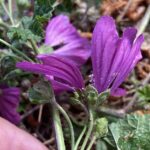Μολόχα, Μαλάχη η δασική
Etymology of Malva sylvestris: The Latin name of the genus "Malva" originates from the Ancient Greek "μαλάχη" [malache], which may derive from the verb "μαλάσσω" [malasso], meaning "to soften, soothe", referring to the leaves and an ointment made from the seeds which were supposed to be soothing to the skin. The awkward epithet given to this species, "Sylvestris", is Latin and means "pertaining to the woods, growing in the wild", an epithet that does not match with the species' common habitat that has almost nothing to do with the woods (roadsides and uncultivated fields).
There are at least nine Malva species in the wild Cypriot habitat.
Malva sylvestris is a relatively common plant which grows all around the island except for the northeastern part. It appears up to an altitude of 1375 metres. It primarily grows on roadsides or uncultivated fields. Its flowering period is between February and September.
How to identify Malva sylvestris:
Besides the flowers, the key to identifying the Malva species whose flowers look similar is primarily the epicalyx (a smaller calyx preceding the calyx). Sylvestris's segments of the epicalyx are free (Malva multiflora has smaller pink flowers but the segments of the epicalyx are partly united; it is the tallest of the Cyprus species, it may reach between 30 - 200 cm high, and in contrary to sylvestris, it has slightly pubescent stem and petioles); the epicalyx has obovate segments; its flowers are clustered and axillary (Malva aegyptia has similar flowers but they are solitary and the plant reaches up to 15 cm high); its petals are 15-20 mm long; the plant is between 30-150 cm high (Malva nicaeensis has similar flowers but its petals are only 7-10 mm long and the plant is between 7-40 cm high).

